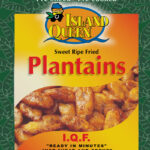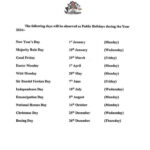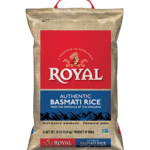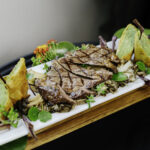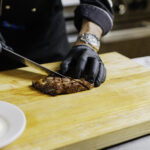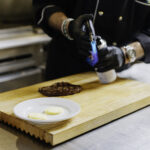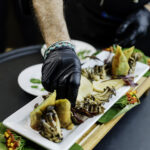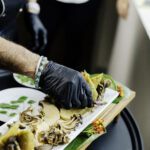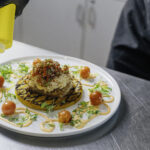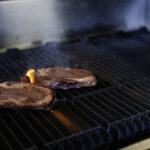LIONFISH should be the latest addition to your seafood menu.
Every Bahamian loves conch, snapper, grouper and lobster, stewed, pan-fried, “cracked”, ceviche style, frittered and in a variety of fresh salads. Visitors come from all over the world to sample the delicious dishes made with the bounty of the seas. Fishermen in The Bahamas support their families and communities by catching, or trapping, and selling fish and shellfish to restaurants, hotels, and wholesalers like Tropic Seafood that buy, grade, package and export Bahamian lobster to the US, Europe and Asia. For generations, fishing has been a sizable industry for The Bahamas, and every Bahamian wishes for their descendants to know the pleasure of the perfect Conch Salad, Grouper Fingers or Steamed Snapper dinner.

However, there is a chance that future Bahamians and visitors to this country will only hear stories of the days when people enjoyed native seafood. An invasion has begun that spells doom and gloom for future seafood menus, one that grows in strength daily and shows no sign of slowing.
 It all began in 1992, when the notorious Hurricane Andrew moved through The Bahamas, Florida, Louisiana, Georgia and Mississippi. The Category 5 super storm devastated large areas of southern Florida, causing $25 billion worth of damage and killing 44 people. Andrew passed over The Bahamas as a Category 4 strength hurricane with 18 ft storm surges and caused over $250 million of damage with 4 fatalities. At the end of Hurricane Andrew’s rampage, more than 65 people had died and close to $34 billion worth of damage. But Andrew didn’t stop at destroying homes.
It all began in 1992, when the notorious Hurricane Andrew moved through The Bahamas, Florida, Louisiana, Georgia and Mississippi. The Category 5 super storm devastated large areas of southern Florida, causing $25 billion worth of damage and killing 44 people. Andrew passed over The Bahamas as a Category 4 strength hurricane with 18 ft storm surges and caused over $250 million of damage with 4 fatalities. At the end of Hurricane Andrew’s rampage, more than 65 people had died and close to $34 billion worth of damage. But Andrew didn’t stop at destroying homes.

The churning sea caused by storm surge and powerful winds up to 175 mph wreaked havoc on the sea bed and sea life. Sponges were smothered with sediment, shellfish and coral were ripped from reefs, and debris and chemicals were pushed into the water, affecting fish and sea life. An aquarium near Biscayne Bay in Florida was smashed, and less than a dozen tiny Lionfish were released into the warm waters. These tenacious little fighting fish were to become the start of a wave of destruction that now stretches from the south Caribbean to North Carolina. Irresponsible fish owners dumping their tanks into the ocean added to the numbers and by 2005, the first lionfish were noticed in the shallow waters of Exuma in The Bahamas. Continued introduction of lionfish by aquarium owners is now considered to be the the primary cause of the lionfish infestation throughout the Caribbean.
Oregon State University professor Mark Hixon was studying reef fish in the Exuma Islands at the time, and said that at first no one really paid attention to the lionfish. But by 2007, there was a “population explosion” of lionfish who were steadily eating all of the other reef fish, and so he had no choice but to start studying this flamboyant predator. By 2008, Hixon had written that his research showed that one lionfish can reduce a reef’s fish population by 75% in only 5 weeks.
A 2009 study of the reefs in the Bahamian Southwest Marine Park conducted by a team of divers and led by Dr. Craig Dahlgren found that “While fish diversity was fairly high at most sites, fishery species such as Nassau grouper, conch and crawfish had low abundances and were not seen at many sites. In contrast the non-native lionfish was seen at over 80% of sites visited and often occurred in high abundance.”

| BITE OF A LION The diet of the lionfish includes over 40 species of fish and crustacean species; this broad diet suggests that this invasive species may become a real threat to many native reef fish populations through direct predation as well as competition for food resources with native piscivores. Researchers have reported that within a short period after lionfish are introduced into a new area, survival of native reef fishes declines by about 80 percent. Further, the voracious feeding behavior of the lionfish may impact the abundance of ecologically important species such as parrotfish and other herbivorous fishes that keep seaweeds and macroalgae from overgrowing corals. The dorsal- and anal-fin spines of the lionfish contain potent venom that can administer a painful sting. When threatened, the lionfish will arch its back, point its dorsal spines at the aggressor, and swim forward rapidly in order to inflict a sting. Consequently, the lionfish poses a threat to fishermen, divers, and wildlife inspectors. Symptoms of the sting may include: extreme pain, swelling, redness, bleeding, nausea, numbness, joint pain, anxiety, headache, disorientation, dizziness, nausea, paralysis, and convulsions. – Aquatic Nuisance Species Task Force Report |
The Lionfish will literally eat anything that moves, as long as it can fit in its mouth. The average Nassau grouper is too big, but juvenile fish and baby shellfish are the perfect size for the very greedy lionfish to devour by the dozen. Natural nurseries located as in the warm, shallow waters are particularly at risk, and lionfish also have no problem surviving in deeper and colder water. Populations are affected by “direct predation as well as competition for food resources” with native fish, according to the Aquatic Nuisance Species task force. Fish, conch and lobster being caught today will not have a chance to have their numbers replenished as long as their young are being consumed by lionfish. This translates to less fresh seafood, higher prices and a disturbance in the natural balance. Lionfish also reproduce at a very rapid rate, up to once a week, year-round.
How is this massive invasion being handled? Efforts initiated by conservationists and concerned citizens are today being taken on by divers, restaurants, students, government agencies and numerous organisations, to raise public awareness of how serious the problem has become. The Lion Fish has no natural enemy in the sea, as even sharks are not interested in the poisonous sting that a frightened or threatened lionfish will impart on the offensive. The best plan to reduce lionfish numbers is to ignite a desire for lionfish fillet by the general public, as man is the only species capable of causing endangerment and possible extinction of any animal. The more people request lionfish fillet, the more encouraged divers are to spear and sell it. For every lionfish killed, hundreds of baby snappers, conch, lobster and grouper have a better chance of surving to adulthood and the Bahamian table. Groups throughout the Caribbean and Florida have organised Lionfish fishing tournaments, cook-offs, derbies and campaigns, with noticeable reduction in numbers in some areas.
WAYS TO HELP
- Report all lionfish sightings
- Spear and kill any lionfish you see while diving or fishing
- Sell your lionfish fillet to Tropic Seafood or another local buyer such as a restaurant or wholesaler
- EAT LIONFISH! It tastes similar to hogfish
- Ask for lionfish at all local restaurants
- Buy lionfish when you see it offered on a menu
- Support lionfish tournaments and awareness events
- Contribute to the Bahamas National Trust
- Share info on lionfish on your social media
- Buy a Lionfish T-shirt
| “In Bonaire, a diving mecca the Dutch West Indies, the first lionfish was caught in 2009, and within two years they were proliferating, according to Fadilah Ali of the University of Southampton. But some 300 volunteers were given special spears, more than 10,000 lionfish were killed and soon their density dropped in the areas favoured by divers. ‘Today, on a typical dive, you’ll see very few or no lionfish,'”- Predatory Lionfish Decimating Caribbean Reefs |
USEFUL LINKS
- Tropic Seafood – buy & sell lionfish
- Lionfish Fact Sheet (Bahamas National Trust)
- Cape Eleuthera Institute – A facility in Eleuthera, Bahamas that studies the environment and encourages people to explore, learn, experience and find ways to protect it. Initiators of the “You Slay, We Pay” program, where fishermen are paid market price for lionfish fillet and fins are used for jewellery.
- REEF.org – Report a lionfish sighting anywhere you see it and get resources, info on workshops and events and many more facts.
- 2014 Lionfish Derby Series
- HOPE! Jamaica Reports Big Drop in Lionfish Sightings – 4 years after enacting a national campaign to aggressively combat the invasive lionfish, Jamaican researchers at UWI report a 66% reduction in sighting in certain areas.
- Lionfish Recipes – (World Lionfish Hunters Association)
- Chef Charon McKenzie @ the BFS Food Show 2013 – Lionfish Cakes (photos)
BFS RECIPE: Lionfish Tacos
DOWNLOAD AS PDF: Lionfish Tacos
RELATED ARTICLES
 Florida turns to smart phone app to track invasive lionfish
Florida turns to smart phone app to track invasive lionfish The Great Debate: Predators vs Lionfish
The Great Debate: Predators vs Lionfish Invasive Lionfish Fillets Fuel Conservation Campaign in Jamaica
Invasive Lionfish Fillets Fuel Conservation Campaign in Jamaica Lionfish Soca
Lionfish Soca Scourge of the Lionfish
Scourge of the Lionfish Invasive lionfish threaten Gulf of Mexico ecosystem
Invasive lionfish threaten Gulf of Mexico ecosystem Florida Officials Declare Open Season on Lionfish
Florida Officials Declare Open Season on Lionfish Predatory Lionfish Decimating Caribbean Reefs
Predatory Lionfish Decimating Caribbean Reefs Lionfish at deep sea worry conservationists
Lionfish at deep sea worry conservationists Lionfish, the savory menace, swims its way onto restaurant menus
Lionfish, the savory menace, swims its way onto restaurant menus
VIDEO
Invasion of the Lionfish: Impact and Action from Southern Eleuthera
General information on lionfish living in the waters off Southern Eleuthera. Includes footage of a Bahamian fisherman spearing lionfish in 20 ft water, filleting lionfish and preparing it as a meal. Narrated by students of Deep Creeks school and produced by Will Strathmann of the Island School



REFERENCES
Hurricane Andrew (wikipedia.com) https://en.wikipedia.org/wiki/Hurricane_Andrew
Spreading Lionfish Invasion Threatens Bahamas (www.npr.com) https://www.npr.org/templates/story/story.php?storyId=111695369
Aquatic Nuisance Species Task Force page on Lionfish https://www.anstaskforce.gov/spoc/lionfish.php
“Predatory Lionfish Decimating Caribbean Reefs” by Christopher Pala (https://www.ipsnews.net/2014/02/predatory-lionfish-prove-elusive-menu-item/)
REA (Rapid Ecological Assessment) of Proposed Southwest Marine Park (BNT website) https://www.bnt.bs/press-releases/REA-of-Proposed-Southwest-Marine-Park






